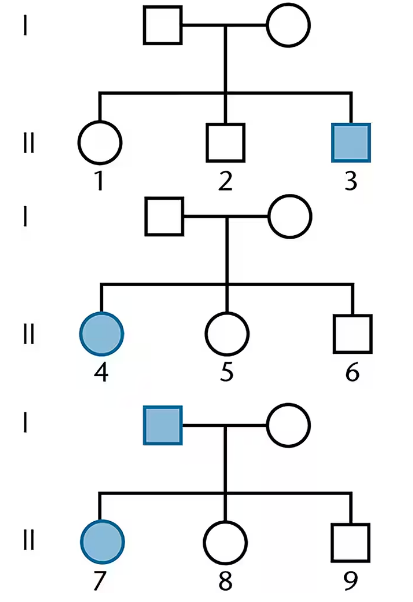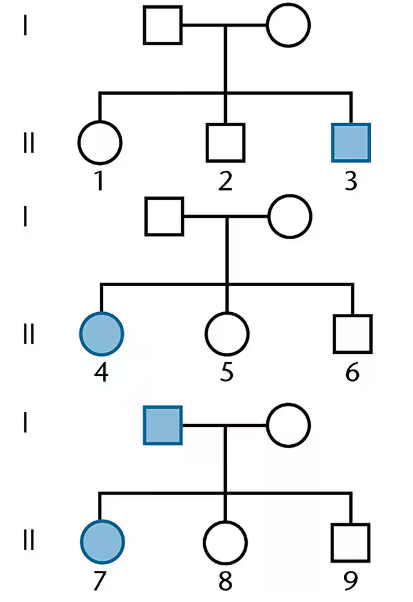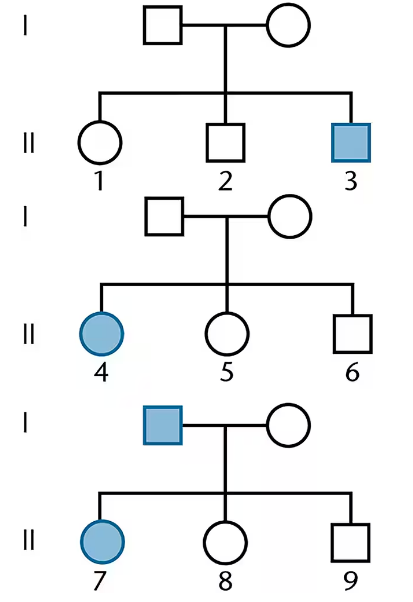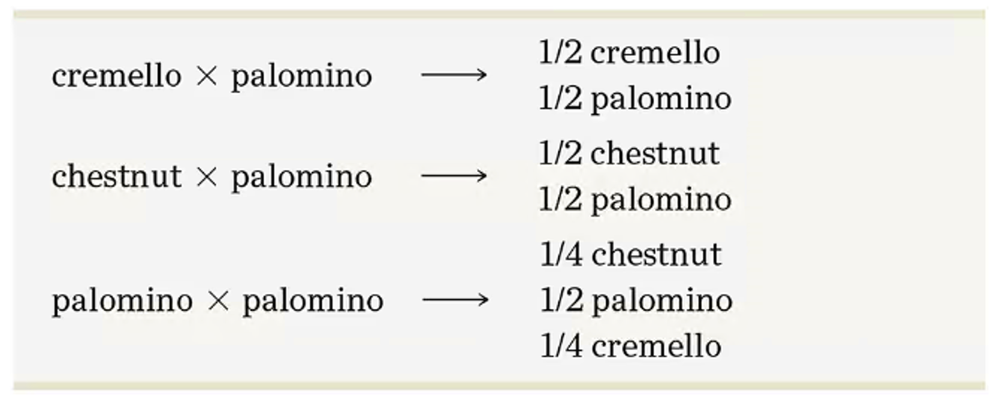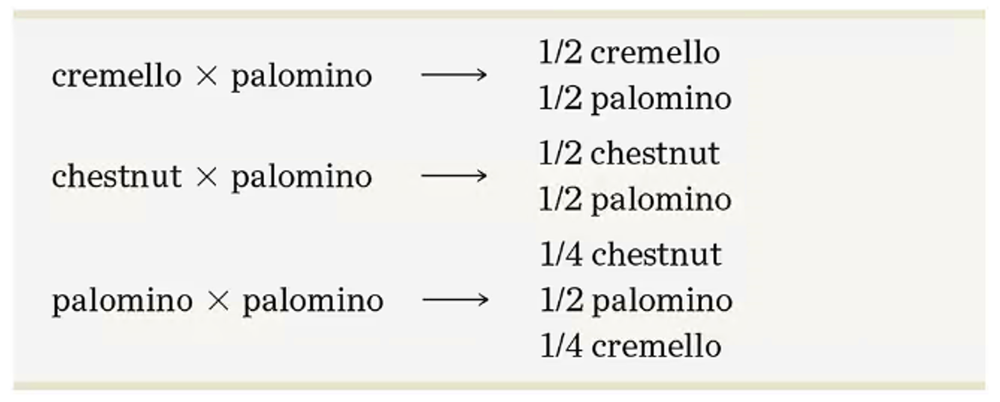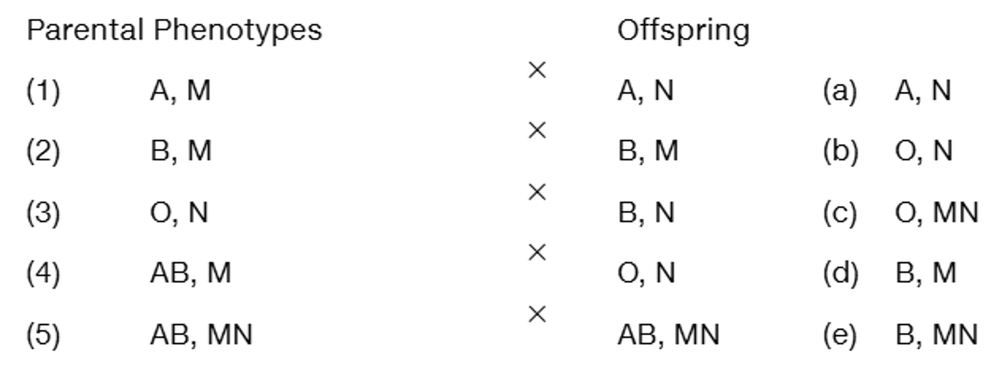 Back
BackProblem 19
In another cross, the frog geneticist from Problem 18 mated two purple, utterers with the results shown here. What were the genotypes of the parents? <IMAGE>
Problem 20
In cattle, coats may be solid white, solid black, or black-and-white spotted. When true-breeding solid whites are mated with true-breeding solid blacks, the generation consists of all solid white individuals. After many matings, the following ratio was observed in the generation:
<IMAGE>
Explain the mode of inheritance governing coat color by determining how many gene pairs are involved and which genotypes yield which phenotypes. Is it possible to isolate a true-breeding strain of black-and-white spotted cattle? If so, what genotype would they have? If not, explain why not.
Problem 21a
Consider the three pedigrees below, all involving a single human trait.
Which combination of conditions, if any, can be excluded? dominant and X-linked dominant and autosomal recessive and X-linked recessive and autosomal
Problem 21b
Consider the three pedigrees below, all involving a single human trait.
For each combination that you excluded, indicate the single individual in generation II (e.g., II-1, II-2) that was most instrumental in your decision to exclude it. If none were excluded, answer 'none apply.'
Problem 21c
Consider the three pedigrees below, all involving a single human trait.
Given your conclusions in part (a), indicate the genotype of the following individuals: II-1, II-6, II-9 If more than one possibility applies, list all possibilities. Use the symbols A and a for the genotypes.
Problem 22
Labrador retrievers may be black, brown (chocolate), or golden (yellow) in color (see chapter-opening photo). While each color may breed true, many different outcomes are seen when numerous litters are examined from a variety of matings where the parents are not necessarily true breeding. Following are just some of the many possibilities.
(a) black x brown → all black
(b) black x brown → 1/2 black, 1/2 brown
(c) black x brown → 3/4 black, 1/4 golden
(d) black x golden → all black
(e) black x golden → 4/8 golden 3/8 black 1/8 brown
(f) black x golden → 2/4 golden 1/4 black 1/4 brown
(g) brown x brown → 3/4 brown 1/4 golden
(h) black x black → 9/16 black 4/16 golden, 3/16 brown
Propose a mode of inheritance that is consistent with these data, and indicate the corresponding genotypes of the parents in each mating. Indicate as well the genotypes of dogs that breed true for each color.
Problem 23
Three autosomal recessive mutations in Drosophila, all with tan eye color (r1, r2, and r3), are independently isolated and subjected to complementation analysis. Of the results shown below, which, if any, are alleles of one another? Predict the results of the cross that is not shown—
Problem 24a
Horses can be cremello (a light cream color), chestnut (a brownish color), or palomino (a golden color with white in the horse's tail and mane). Of these phenotypes, only palominos never breed true.
From the results given above, determine the mode of inheritance by assigning gene symbols and indicating which genotypes yield which phenotypes.
Problem 24b
Horses can be cremello (a light cream color), chestnut (a brownish color), or palomino (a golden color with white in the horse's tail and mane). Of these phenotypes, only palominos never breed true.
Predict the F1 and F2 results of many initial matings between cremello and chestnut horses.
Problem 25a
Pigment in mouse fur is only produced when the C allele is present. Individuals of the cc genotype are white. If color is present, it may be determined by the A, a alleles. AA or Aa results in agouti color, while aa results in black coats. What F₁ and F₂ genotypic and phenotypic ratios are obtained from a cross between AACC and aacc mice?
Problem 25b
Pigment in mouse fur is only produced when the C allele is present. Individuals of the cc genotype are white. If color is present, it may be determined by the A, a alleles. AA or Aa results in agouti color, while aa results in black coats. In three crosses between agouti females whose genotypes were unknown and males of the aacc genotype, the following phenotypic ratios were obtained:
(1) 8 agouti
(2) 9 agouti
(3) 4 agouti, 8 white 10 black, 5 black, 10 white
Problem 26
Five human matings (1–5), identified by both maternal and paternal phenotypes for ABO and MN blood-group antigen status, are shown on the left side of the following table:
Each mating resulted in one of the five offspring shown in the right-hand column (a–e). Match each offspring with one correct set of parents, using each parental set only once. Is there more than one set of correct answers?
Problem 27
Two mothers give birth to sons at the same time at a busy urban hospital. The son of mother 1 is afflicted with hemophilia, a disease caused by an X-linked recessive allele. Neither parent has the disease. Mother 2 has a normal son, despite the fact that the father has hemophilia. Several years later, couple 1 sues the hospital, claiming that these two newborns were swapped in the nursery following their birth. As a genetic counselor, you are called to testify. What information can you provide the jury concerning the allegation?
Problem 28
In Dexter and Kerry cattle, animals may be polled (hornless) or horned. The Dexter animals have short legs, whereas the Kerry animals have long legs. When many offspring were obtained from matings between polled Kerrys and horned Dexters, half were found to be polled Dexters and half polled Kerrys. When these two types of F₁ cattle were mated to one another, the following F₂ data were obtained:
3/8 polled Dexters
3/8 polled Kerrys
1/8 horned Dexters
1/8 horned Kerrys
A geneticist was puzzled by these data and interviewed farmers who had bred these cattle for decades. She learned that Kerrys were true breeding. Dexters, on the other hand, were not true breeding and never produced as many offspring as Kerrys. Provide a genetic explanation for these observations.
Problem 29a
What genetic criteria distinguish a case of extranuclear inheritance from:
(a) a case of Mendelian autosomal inheritance
Problem 29b
What genetic criteria distinguish a case of extranuclear inheritance from: (b) a case of X-linked inheritance?
Problem 30
The specification of the anterior–posterior axis in Drosophila embryos is initially controlled by various gene products that are synthesized and stored in the mature egg following oogenesis. Mutations in these genes result in abnormalities of the axis during embryogenesis, illustrating maternal effect. How do such mutations vary from those involved in organelle heredity that illustrate extranuclear inheritance? Devise a set of parallel crosses and expected outcomes involving mutant genes that contrast maternal effect and organelle heredity.
Problem 31b
The maternal-effect mutation bicoid (bcd) is recessive. In the absence of the bicoid protein product, embryogenesis is not completed. Consider a cross between a female heterozygous for the bicoid mutation and a homozygous male
b.Predict the outcome (normal vs. failed embryogenesis) in the and generations of the cross described.
Problem 32a
Students taking a genetics exam were expected to answer the following question by converting data to a “meaningful ratio” and then solving the problem. The instructor assumed that the final ratio would reflect two gene pairs, and most correct answers did. Here is the exam question:
<IMAGE>
Convert the data to a meaningful ratio that allows you to explain the inheritance of color. Determine the number of genes involved and the genotypes that yield each phenotype.”
a.Solve the problem for two gene pairs. What is the final ratio?
Problem 32b
Students taking a genetics exam were expected to answer the following question by converting data to a “meaningful ratio” and then solving the problem. The instructor assumed that the final ratio would reflect two gene pairs, and most correct answers did. Here is the exam question:
<IMAGE>
Convert the data to a meaningful ratio that allows you to explain the inheritance of color. Determine the number of genes involved and the genotypes that yield each phenotype.”
b. A number of students failed to reduce the ratio for two gene pairs as described above and solved the problem using three gene pairs. When examined carefully, their solution was deemed a valid response by the instructor. Solve the problem using three gene pairs.
Problem 32b
Students taking a genetics exam were expected to answer the following question by converting data to a “meaningful ratio” and then solving the problem. The instructor assumed that the final ratio would reflect two gene pairs, and most correct answers did. Here is the exam question:
“Flowers may be white, orange, or brown. When plants with white flowers are crossed with plants with brown flowers, all the flowers are white. For flowers, the following data were obtained:
<IMAGE>
Convert the data to a meaningful ratio that allows you to explain the inheritance of color. Determine the number of genes involved and the genotypes that yield each phenotype.”
b. A number of students failed to reduce the ratio for two gene pairs as described above and solved the problem using three gene pairs. When examined carefully, their solution was deemed a valid response by the instructor. Solve the problem using three gene pairs.
Problem 33
In four o’clock plants, many flower colors are observed. In a cross involving two true-breeding strains, one crimson and the other white, all of the generation were rose color. In the , four new phenotypes appeared along with the and parental colors. The following ratio was obtained:
Propose an explanation for the inheritance of these flower colors.
Problem 34
Below is a partial pedigree of hemophilia in the British Royal Family descended from Queen Victoria, who is believed to be the original 'carrier' in this pedigree.
Analyze the pedigree and indicate which females are also certain to be carriers. What is the probability that Princess Irene is a carrier?

